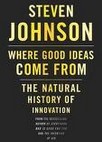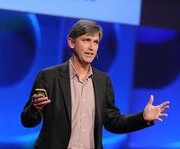 奇思妙想是如牛顿那样深入思考而来?不,在不同的想法汇聚一堂、相互碰撞与摩擦时,新颖有趣的思想火花往往更容易闪现。奇思妙想是如达尔文所述的那样是“灵光一现”而来?不,灵感在瞬间迸出之前往往经历了漫长的孕育期。那么,科学、艺术以及生活中那种种令人惊叹的奇思妙想究竟是经历了怎样“曲折”的孕育历程最终诞生的呢?也许,下面这位对人类创新史颇有研究的学者之言,会让你茅塞顿开、恍然大悟。
奇思妙想是如牛顿那样深入思考而来?不,在不同的想法汇聚一堂、相互碰撞与摩擦时,新颖有趣的思想火花往往更容易闪现。奇思妙想是如达尔文所述的那样是“灵光一现”而来?不,灵感在瞬间迸出之前往往经历了漫长的孕育期。那么,科学、艺术以及生活中那种种令人惊叹的奇思妙想究竟是经历了怎样“曲折”的孕育历程最终诞生的呢?也许,下面这位对人类创新史颇有研究的学者之言,会让你茅塞顿开、恍然大悟。
 This is a picture of the Grand Cafe here in Oxford. And I wanted to show it to you because the English coffeehouse was crucial to the development and spread of one of the great intellectual flowerings of the last 500 years, what we now call the Enlightenment3). One of the things that make the coffeehouse important is the architecture of the space. It was a space where people would get together from different backgrounds, different fields of expertise. Ideas would get together there. An astonishing number of innovations from this period have a coffeehouse somewhere in their story.
This is a picture of the Grand Cafe here in Oxford. And I wanted to show it to you because the English coffeehouse was crucial to the development and spread of one of the great intellectual flowerings of the last 500 years, what we now call the Enlightenment3). One of the things that make the coffeehouse important is the architecture of the space. It was a space where people would get together from different backgrounds, different fields of expertise. Ideas would get together there. An astonishing number of innovations from this period have a coffeehouse somewhere in their story.
这是牛津格朗德咖啡屋的一张照片,我之所以想让大家看看这张照片,是因为英国的咖啡屋在过去的500年间,对一场伟大的思想运动的发展和传播起了至关重要的作用,这场运动就是我们现在所说的启蒙运动。咖啡屋之所以能发挥如此重要的作用,其中一个原因就是它提供了独特的空间:背景不同、专业各异的人们能在此汇聚一堂;于是,思想的火花也在这里碰撞。启蒙运动时期,不知有多少发明创造的故事中都少不了咖啡屋的一席之地。
I’ve been spending a lot of time thinking about coffeehouses, because I’ve been on this quest to investigate this question of where good ideas come from. What are the environments that lead to unusual levels of innovation? I’ve looked at those environments like the coffeehouse; I’ve looked at media environments; I’ve even gone to biological environments; and what I’ve been looking for is shared patterns that show up again and again in all of these environments. And I think I’ve found a few.
我花了很多时间思考咖啡屋的奥秘,因为我一直在苦苦探寻,想弄清楚一个问题:奇思妙想究竟从何而来?什么样的环境才能孕育出不凡的发明创造呢?我观察过咖啡馆那样的环境,也观察过媒体环境,甚至是生物环境,而我一直在寻找的就是在所有这些环境中一再出现的共同模式。我想我已经找到了一些。
Liquid Network 孕育创新的“液态网络”
But what you have to do to really understand these principles is you have to do away with4) the way in which our conventional metaphors steer us towards certain concepts of idea-creation. We have this very rich vocabulary to describe moments of inspiration: the flash of insight, epiphanies5), “eureka6)” moments. All of these concepts share this basic assumption, which is that an idea is a single thing; it’s something that happens often in a wonderful illuminating moment.
不过,要想真正理解这些模式,就必须摈弃原来的那套路子,对于创意的某些概念,不能让传统的比喻说法来牵着我们的鼻子走。我们有许多形容灵感一现的词汇,比如“灵光一闪” “茅塞顿开” “恍然大悟”。所有这些概念都有一个基本的假设,那就是创意是一种凭空出现的东西,往往诞生在某一神奇的眼前一亮的瞬间。
But what I would argue is that an idea is a network on the most elemental level. An idea is a new network of neurons firing in sync with7) each other inside your brain. And the question is: how do you get your brain into environments where these new networks are going to be more likely to form? It turns out that network patterns of the outside world mimic8) a lot of the network patterns of the internal world of the human brain.
但我认为,从最本质的层面来说,创意是一种网络。人类大脑中的神经元细胞相互连结成一个新的神经网络,同步发射神经脉冲传递信息,创意由此诞生。问题是:怎样让你的大脑接触到那些更有可能促成这种新网络形成的环境呢?事实证明,外部世界的网络模式在很大程度上与人脑内部的网络模式相仿。
We take ideas from other people, and we stitch9) them together into new forms, and we create something new. That’s really where innovation happens. And that means that we have to change some of our models of what innovation and deep thinking really look like. This is one vision of it. Another is Newton and the apple. You know, you’re sitting there thinking a deep thought, and the apple falls from the tree, and you have the theory of gravity10). In fact, the spaces that have historically led to innovation tend to look like this. This is Hogarth11)’s famous painting of a political dinner at a tavern. This is the kind of chaotic environment where ideas were likely to come together, where people were likely to have new, interesting, unpredictable collisions. So, if we’re trying to build organizations that are more innovative, we have to build spaces that look a little bit more like this.
我们借鉴和参考别人的点子,进行整合加工,构成新的形态,就创造出新的东西来了。所谓的创新事实上就是如此诞生的。而这就意味着我们必须打破思维定势,不能一提到创新和深度思考,脑海里浮现的总是那几个画面。这是其中一个(译注:作者在演讲时有PPT,讲到这里时,PPT上播放着“思想者”的雕塑照片);还有一个是牛顿和苹果:牛顿坐在树下思考问题,一颗苹果掉了下来,于是他就发现了万有引力定律。事实上,历史上孕育各种发明创造的地方往往是像这样的:这是荷加斯的一幅名画(见左图),描绘的是一家酒馆里举行政治宴会的场景。正是在这种混乱嘈杂的环境中不同的想法才有可能汇聚一堂,人们才有可能在不经意间碰撞出新颖有趣的思想火花。所以,如果我们想要建一个有利于创新的机构,就得营造一些像这家酒馆一样的场所。
A few years ago, a wonderful researcher named Kevin Dunbar decided to go around and basically do the Big Brother12) approach to figuring out where good ideas come from. He went to a bunch of science labs around the world and videotaped everyone as they were doing every little bit of their job. What happened when Dunbar looked at the tape is that almost all of the important breakthrough ideas did not happen alone in the lab. They happened at the conference table at the weekly lab meeting, when everybody got together and shared their kind of latest data and findings. I’ve started calling it the “liquid network”, where you have lots of different ideas that are together, different backgrounds, different interests, jostling with each other, bouncing off each other—that environment, in fact, leads to innovation.
几年前,一名叫凯文·邓巴的研究人员决定对“奇思妙想从何而来”这个问题一探究竟,他的研究方法和真人秀节目《老大哥》差不多:他走访了世界各地的许多科学实验室,拍下了科研人员工作中的一点一滴。回看这些录像时,邓巴发现几乎所有具有重大突破性的创意都不是由科研人员一个人在实验室里想出来的,而是诞生在每周的例会上:大家聚在会议桌前,交流彼此的最新数据和发现,好点子就随之冒出来了。这就是我所说的“液态网络”,在这种网络里,背景不同、兴趣各异的人相互交流切磋,你一言,我一语,五花八门的观点就像液体的分子一样在这里发生碰撞——其实这就是孕育创新的环境。
Slow Hunch13) 漫长的灵感孕育期
 Often people like to condense their stories of innovation down to kind of shorter time frames. But if you look at the historical record, it turns out that a lot of important ideas have very long incubation periods. I call this the “slow hunch”. We’ve heard a lot about hunch and instinct and blink-like sudden moments of clarity, but a lot of great ideas linger on, sometimes for decades, in the back of people’s minds.
Often people like to condense their stories of innovation down to kind of shorter time frames. But if you look at the historical record, it turns out that a lot of important ideas have very long incubation periods. I call this the “slow hunch”. We’ve heard a lot about hunch and instinct and blink-like sudden moments of clarity, but a lot of great ideas linger on, sometimes for decades, in the back of people’s minds.
人们在讲述自己发明创造的经历时,往往喜欢对创新经历的时间进行一些浓缩。然而,如果翻阅一下历史记载,你会发现许多重大发明都经历了漫长的孵育过程。我把这叫做“漫长的灵感孕育期”。我们总是听到“灵感” “直觉”和“灵光一现”这样的字眼,但许多伟大的创意都曾长时间盘旋在人们的脑海中,有时甚至长达数十年。
Darwin is a great example of this. Darwin himself tells the story of coming up with the idea for natural selection as a classic “eureka” moment. However, about a decade or two ago, a wonderful scholar named Howard Gruber14) went back and looked at Darwin’s notebooks from this period. What Gruber found was that Darwin had the full theory of natural selection for months and months and months before he had his alleged epiphany. And so what you realize is that Darwin had the idea, but was unable to fully think it yet. And that is actually how great ideas often happen; they fade into view over long periods of time.
达尔文就是一个很好的例子。他本人在讲述自己如何萌发出物竞天择学说的想法时,采用的就是典型的“恍然大悟”的说法。但十几年前,一个叫霍华德·格鲁伯的了不起的学者,这个人很了不起,他回过头去看了看达尔文该时期的笔记时,却发现达尔文早在他声称“茅塞顿开”的数月前就有了整个理论的雏形。这样你就明白了,达尔文早就有了想法,只不过想法还不成熟而已。事实上,伟大的想法就是这么产生的;它们需要很长一段时日才会慢慢地浮出水面。
Now the challenge for all of us is: how do you create environments that allow these ideas to have this kind of long half-life? Now a couple of companies, like Google, they have innovation time off, 20 percent time. In a sense, those are hunch-cultivating mechanisms in an organization. And the other thing is to allow those hunches to connect with other people’s hunches. You have half of an idea, somebody else has the other half, and if you’re in the right environment, they turn into something larger than the sum of their parts. We often talk about the value of protecting intellectual property, having secretive R&D labs, patenting everything that we have, so that people will be incentivized to come up with more ideas. But I think there’s a case to be made that we should spend at least as much time, if not more, valuing the premise of connecting ideas and not just protecting them.
现在我们所有人面临的挑战是:如何才能创造一个合适的环境,让这些创意有如此长的“半成熟期”呢?现在,一些像谷歌这样的公司都会留出20%的时间,让员工休创新假。从某种意义上说,这就是机构中的灵感培育机制。还有一点,就是让这些灵感与别人的灵感两相结合。你有一个点子,别人也有一个点子,遇到了适宜的环境,两个点子一结合,一加一就会远大于二。我们总是认为保护知识产权、设立秘密的研发实验室和普及专利化非常重要,只有这样才能激励人们不断创新。然而,我想说的是,我们不应只是去保护创意,而忽视了交流创意,至少交流创意应得到我们同等的重视。
An Illuminating Story 一个有启发性的故事
And I’ll leave you with this story. It’s October of 1957, and Sputnik15) has just launched. Two researchers from the Applied Physics Lab associated with Johns Hopkins University are at the cafeteria table having an informal conversation with a bunch of their colleagues. These two guys are named Guier and Weiffenbach. One of them says, “Hey, has anybody tried to listen for this thing? There’s this, you know, man-made satellite up there in outer space that’s obviously broadcasting some kind of signal. We could probably hear it, if we tune in.”And so Guier and Weiffenbach go back to Weiffenbach’s office, and they start kind of noodling around. After a couple of hours, they actually start picking up the signal.
最后,我再给大家讲一个故事。那是1957年的10月,当时苏联的“伴侣号”人造地球卫星刚刚发射上天,约翰斯·霍普金斯大学应用物理实验室的两个研究员正坐在一家咖啡馆里和一群同事闲聊。这俩人分别叫吉尔和韦芬巴赫。其中一个说道:“嘿,有谁想过听听那玩意儿的声音吗?你瞧,这颗人造卫星在太空里,显然是在发射某种信号,对吧?调对了频率,没准儿就能听到那信号呢。”于是两人回到韦芬巴赫的办公室,开始胡乱地调来调去。没想到几个小时之后,他俩真的接收了信号。
These two guys are sitting there listening to this signal, and people start coming into the office and saying, “Wow, that’s pretty cool. Can I hear? ” And before long, they think, “Well jeez, this is kind of historic. We may be the first people in the United States to be listening to this. We should record it.” And so they bring in this big, clunky16) analog tape recorder, and they start recording these little bleeps. And they start writing date stamp, time stamps for each little bleep that they record. And they start thinking, “Well gosh, we’re noticing small little frequency variations here. We could probably calculate the speed that the satellite is traveling.” Then they played around with17) it, and they talked to a couple of their colleagues who had other kind of specialties. And they said, “Jeez, you know, we think we could actually figure out the points at which the satellite is closest to our antennae18) and the points at which it’s farthest away. ” At the end of about three or four weeks, it turns out they have mapped the exact trajectory19) of this satellite around the Earth.
他俩坐在那儿聚精会神地听信号,其他人纷纷涌进办公室,说道:“哇,这太厉害了。能让我听一下吗?”很快,他们意识到:“天哪,这可是历史性的一刻啊!我们也许是全美国最先听到这个信号的人。我们应该把它录下来!”于是,他们就搬来一台庞大笨重的模拟磁带录音机,开始录下这些微弱的哔哔声,还为录下的每一个哔哔声记下了日期和时间。接着他们又想:“天哪,我们注意到了细微的频率变化,没准儿可以计算出卫星运行的速度呢!”于是他们进行了反复的计算和论证,还和几个有其他专长的同事讨论了一番。然后他们惊叹道:“呀!知道吗,我们相信我们真能计算出卫星距离我们的天线最近和最远的点。”大约三四周之后,他们果真绘制出了这颗卫星绕地球运行的精确轨道图。
A couple weeks later, their boss Frank McClure says, “Hey, you guys, you’ve figured out an unknown location of a satellite orbiting the planet from a known location on the ground. Could you figure out an unknown location on the ground, if you knew the location of the satellite?” And they thought about it, and they said, “Well, I guess maybe we could.” At the end they came back and said, “Actually, it’ll be easier.” And he said, “Oh, that’s great. Because I have these new nuclear submarines that I’m building. And it’s really hard to figure out how to get your missile so that it will land right on top of Moscow, if you don’t know where the submarine is in the middle of the Pacific Ocean. So we’re thinking, we could throw up a bunch of satellites and use it to track our submarines and figure out their location in the middle of the ocean. Could you work on that problem?”
几周之后,他们的老板弗兰克·麦克卢尔把他们叫去说:“嘿,小伙子们,既然你们已经能根据地面上一个已知点确定人造地球卫星的位置,那么,如果知道了卫星的位置,你们能计算出地面上的某个未知点吗?”他们想了想,说道:“嗯,也许可以。”最后他们回来告诉老板:“事实上,这样更简单。”于是老板说:“噢,那太棒了。是这样的,我现在正在造一批新的核潜艇。如果不知道潜艇在太平洋中的确切位置,就很难弄清楚如何让导弹正好发射到莫斯科的上空。所以,我们在想,也许可以发射一些卫星来跟踪我们的核潜艇,并确定它们在海洋中的位置。你们能搞定这个问题吗?”
That’s how GPS was born. Thirty years later, Ronald Reagan actually opened it up and made it an open platform on top of which anybody could build new technology.
GPS全球定位系统就是这样诞生的。30年后,罗纳德·里根公开了这项技术,使之成为一个开放式平台,任何人都能在这个平台上建立新的技术。
That is a great case study in the marvelous, unplanned, unpredictable power of open innovative systems. When you build them right, they will be led to completely new directions that the creators never even dreamed of. That is how innovation happens. Chance favors the connected mind.
这个例子很好地展现了开放式创新体系具有出人意料、不可预测的惊人力量。完善的创新体系能引领创造者朝着一个意想不到的新方向前进。发明创造就是这么诞生的。机遇永远垂青那些相互交流思想的人。
1. 这篇文章节选自史蒂文·约翰逊在2010年的TED (Technology, Entertainment and Design)会议上发表的演讲。TED是一个致力于“用思想的力量改变世界”的非营利组织。它于1984年由理查德·温曼和哈里·马克思共同创办,从1990年开始每年在美国加州的蒙特雷举办一次会议,如今在世界的其他城市也会每半年举办一次。它最初主要邀请科技、娱乐和设计领域的领军人物来分享他们对自己最热衷的事业的见解,如今会议的内容几乎涉及各个领域。
2. Steven Johnson:史蒂文·约翰逊(1968~),美国大众科学作家,是美国Discovery、Slate和Wired等杂志的专栏作家,曾参与最早的网络电子杂志Feed的创办。其于2005年出版的著作Everything Bad Is Good for You成为美国著名的畅销书。
3. the Enlightment:指欧洲的启蒙运动。启蒙运动指的是18世纪初至1789年法国大革命期间兴起的文化运动,覆盖了自然科学、哲学、伦理学、政治学、文学、教育学等各个领域。启蒙思想家们激烈地批判专制主义和宗教愚昧,宣传自由、平等和民主,要求建立以理性为基础的社会。
4. do away with:结束,减少
5. epiphany [I5pIfEnI] n. 对现实真谛的顿悟或洞察
6. eureka [juE5ri:kE] int. 我发现了(用来表达发现或搞清某物时的胜利心情)
7. in sync with:与……同步的,与……协调的
8. mimic [5mImIk] vt. 模仿,仿效
9. stitch [stItF] vt. 缝,缝合
10. gravity [5^rAvItI] n. 万有引力
11. Hogarth:威廉·荷加斯(William Hogarth, 1697~1764),英国绘画家,艺术理论家,欧洲连环漫画的先驱。他的许多作品都带有对当时政治和风俗的讽刺和嘲笑意味,代表作包括《征服墨西哥》、《妓女生涯》、《浪子生涯》、《文明结婚》等。
12. Big Brother:指真人秀《老大哥》节目。这个节目的基本游戏规则是:六名青年男性、六名青年女性选手共同生活在一个特制的有花园、游泳池、豪华家具的大房子里,大家共享一间卧室、一套起居室和卫生间等。摄像机一天24小时记录他们的一举一动。在共同生活的85天里,选手们每周六要选出两个最不受欢迎的人。
13. hunch [hQntF] n. 直觉,基于直觉的想法
14. Howard Gruber:霍华德·格鲁伯(1922~2005),美国心理学家,创新领域的心理研究先驱之一。他对科技史尤其是查尔斯·达尔文的工作历程有浓厚的兴趣,对创新过程和创新心理学的研究都作出了重大的贡献。
15. Sputnik:指苏联于1957年10月4日发射的“伴侣号”人造地球卫星。它是人类发射的第一颗人造卫星,标志着人类迈开了太空探索的第一步,也直接导致了美国与苏联之间的航天技术竞赛。
16. clunky [klQnk] adj. 笨重的
17. play around with:反复考虑,反复斟酌
18. antenna [An5tenE] (〈复〉-nae [-ni:]) n. 天线
19. trajectory [5trAdVIktErI] n. 轨道,弹道,轨线
